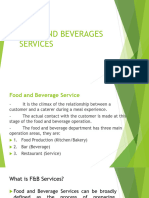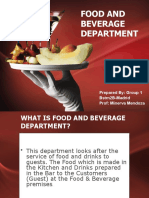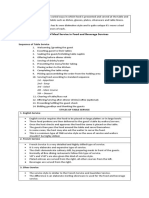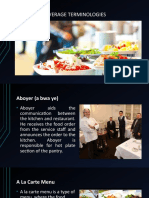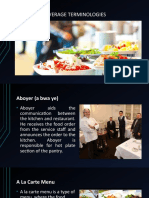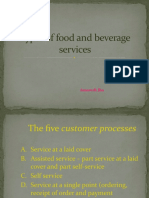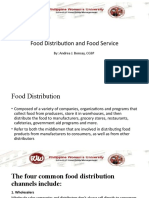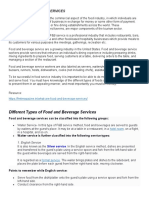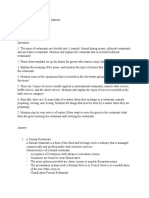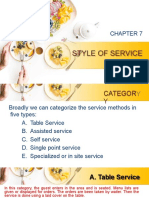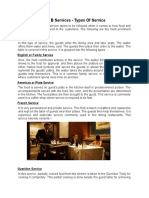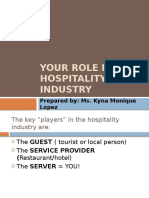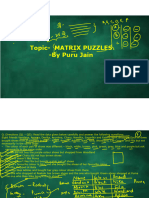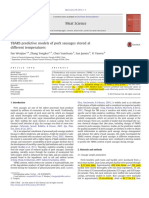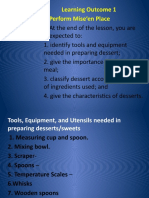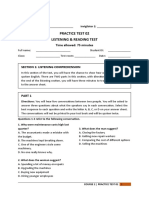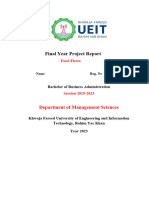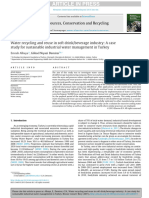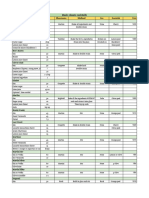Food and Beverage (F&B) Services Refer To The Preparation and Presentation of Meals and Drinks, As Well As
Food and Beverage (F&B) Services Refer To The Preparation and Presentation of Meals and Drinks, As Well As
Uploaded by
Khirzy Joueine PanopioCopyright:
Available Formats
Food and Beverage (F&B) Services Refer To The Preparation and Presentation of Meals and Drinks, As Well As
Food and Beverage (F&B) Services Refer To The Preparation and Presentation of Meals and Drinks, As Well As
Uploaded by
Khirzy Joueine PanopioOriginal Title
Copyright
Available Formats
Share this document
Did you find this document useful?
Is this content inappropriate?
Copyright:
Available Formats
Food and Beverage (F&B) Services Refer To The Preparation and Presentation of Meals and Drinks, As Well As
Food and Beverage (F&B) Services Refer To The Preparation and Presentation of Meals and Drinks, As Well As
Uploaded by
Khirzy Joueine PanopioCopyright:
Available Formats
TH1801
Rationale of Importance
Food and beverage (F&B) services refer to the preparation and presentation of meals and drinks, as well as
the manner of service arrangements. Most restaurants in hotels, resorts, and sometimes apartment hotels
now display their menus near their entrance doors. This allows guests, or simply diners, to get a feel of the
food and drink choices along with their corresponding prices.
F&B played a vital role in the past and at present, and will also play a bigger role in the future of the
accommodation industry since people who usually stay in hotels, resorts, and apartment hotels love food.
Hence, this would be one of the factors in their decision-making. In line with that, the F&B industry has a role
both internally and externally on these accommodation establishments. It provides food to the guests and to
the manpower of that accommodation enterprise or establishment. This also contributes a great deal to the
profits in the accommodation industry. With its increasing importance in business meetings, a range of
personal and social events, and many customers visiting catering establishments frequently, the people behind
F&B tirelessly work to intensify their guests’ experience through their services and products. This also entails
food and beverage in events, banquets, or anything that is outside of catering services.
In hotels and resorts, this industry consists of various units and a huge quantity of staff in order to cater to the
needs of customers inside or outside the mentioned accommodations. These units can be any of the following:
kitchen, restaurant, catering, banquet, room service, minibar, lounge bar, stewarding, and staff canteen.
Characteristics of Food Service
Unlike the production and manufacture of goods, the food service sector has the following unique
characteristics (Tuazon–Disimulacion, 2016):
• Food demand increases at peak times. This refers to whenever the demand for food is at its highest.
Peak times may refer to seasonality or simply the time of the day (breakfast, lunch, or dinner). In the
accommodation industry, peak times may take place during holidays or special events. The more
guests check in, the more likely the occurrence of peak times will be. (ex. ABC Hotel Buffet Restaurant
with a total reservation of 600 pax for New Year’s Eve dinner)
• Menu adjustment is based on stakeholders’ requirements. This means tailor-fitting the F&B menu
with what the stakeholders require. Clients would always be asking for more; thus, the role of F&B is
to meet or even go beyond their expectations. (ex. ABC Hotel Buffet Restaurant is serving bird’s nest
soup as their soup of the day. Due to the request of most of the guests, they replaced it with crab and
corn soup.)
• Food preparation and service are labor intensive. This refers to how challenging the process of food
preparation is, hence requiring more people to work together. This also means that the people behind
F&B are always giving out their best to provide their guests with a remarkable experience. (ex. ABC
Hotel Buffet Restaurant’s cheese omelet is usually prepared one [1] to two [2] hours before breakfast
and would usually require two [2] cooks to prepare and make them, while the others work on
preparing sausages and fried rice.)
• Food is perishable. This refers to the shelf life of the ingredients that are used for making food as well
as the finished products themselves. (ex. ABC Chinese Restaurant did not use the sliced chicken breast
because only a few ordered them. Before the restaurant closed, they threw all the untouched chicken
breasts to ensure that they will be using fresh ones the following day to avoid spoilage.)
• Food preparation follows strict standards of hygiene. This refers to the standards which different F&B
establishments follow to ensure that everything is fresh and won’t do any harm to any consumer. (ex.
ABC Hotel’s buffet restaurant waitresses wear hairnets to prevent human hair—one of the physical
contaminants—from causing food contamination.)
07 Handout 1 *Property of STI
student.feedback@sti.edu Page 1 of 6
TH1801
Categories of Food Service
There are five (5) categories of F&B service in the accommodation industry (Tuazon–Disimulacion, 2016):
• Table Service is when the guests are seated upon entry. The food server hands out the menu and
takes the orders, which can be any of the following:
o English Service is a table service wherein the guest approves the food on the platter before
these are served. Upon his/her approval, the waiter puts the platters on the table, then, either
the guest or the waiter portions the food into the plate of the others.
o Family Service is a table service wherein guests are seated, while servers fill large serving
platters and bowls with food items from the kitchen and set these on the dining tables. The
guests then help themselves, or they pass the food to each other.
o Pre-Plated/American Service is a table service wherein food is pre-plated in the kitchen
before a waitstaff can take it to the guest’s table.
o French Service is a table service that is considered the most formal type of table service.
Partially cooked food is brought from the kitchen on a gueridon (a French side table with a
circular top) or a cart which is also used for the final cooking. The food is completely cooked
in front of the guests; guests can either allow the waitstaff to assist them in portioning the
food or simply do self-service.
o Platter/Russian Service is a table service that is considered as a forerunner to the French
service. This requires that the waiter portions and carves the food on well-decorated silver
platters before serving it to the guests.
• Assisted Service is when the guest enters the dining area and helps himself to the food, either from
a buffet counter or he/she may get served partly at table by waiters and he/she collects any extras
he/she needs from the counter. It can be any of the following:
o Assisted Buffet is when the food is displayed on the buffet table and are portioned by the
waiters or food servers.
o Carvery is when the food is on a stand-alone carving station or may be one of the buffet
sections wherein a waiter or a food server portions some parts of the food which can either
be served to seated guests directly or guests can help themselves.
• Self Service is when guests select their choice of meals from a counter and place these on a tray.
Except for assisted service where waiters and food service staff help the guests, the diners carry their
trays to their seats. It may be any of the following:
o Buffet is where food is displayed on tables. Diners pick up a plate and choose from a varied
menu of soups, salads, appetizers, entrée (main course), and deserts. Food on the buffet table
is usually served within a specific period and payment is either paid before or after the meal.
o Cafeteria is usually found in school, office canteens, and hospitals. Guests choose food from
a display counter informing the food server of their choices, who, in turn plates the food and
hands it over to the guests. Silverware is commonly placed near the trays. Most cafeterias
provide drinking water within the dining area.
o Coffee Shops and Tea Salons are small restaurants that primarily serve coffee-related
beverages such as latte, cappuccino, espresso, and other hot beverages. Some cafes serve
cold beverages and light snacks such as pastries.
07 Handout 1 *Property of STI
student.feedback@sti.edu Page 2 of 6
TH1801
• Single-Point Service is when the guests order the food to be paid and served in one area. Sometimes,
there is a small dining area for customers which is frequented by people-on-the-go. These can be any
of the following:
o Take away is the type of service that provides a designated area where customers can buy
meals quickly. The ordered meal or food is mostly consumed outside the food premises.
o Drive-thru is the type of service wherein customers order their food or meal while not leaving
their vehicles.
o Fast food is when food is served after being ordered and may either be on-the-go or on a pre-
order basis, which is then to be served to or picked up by the customer.
o Vending is the provision of F&B service by means of automatic retailing.
o Kiosks usually complement the main food establishment by providing additional facilities to
serve meals.
o Food court refers to a series of autonomous counter where customers may either order and
eat, buy from different counters and eat in a separate eating area, or order for take away.
o Bar refers to a counter across where alcoholic drinks or refreshments are served.
• Specialized Service is where food and beverages are served in an area not primarily designed for
service. This can be any of the following:
o Tray is when the whole or part of food or meal on a tray is served to the guest/customer.
o Trolley is when the whole or part of food or meal on a trolley is served to the guest/customer.
o Home delivery is when the food can be ordered over the telephone, mobile phone, or online
and can be delivered to one’s desired place of delivery.
o Room is when the guests place their orders over the phone of their hotel room, which are
then transmitted to the kitchen for preparation. A room service attendant or waiter brings up
the order to the room using either a tray or a trolley. The bill is usually included in the hotel
bill upon check-out.
o Drive-in is when guests park their vehicles and are served at their vehicles.
Classifications of Food Service Establishments
Food service establishments may be classified into any of the following (U.S. National Park, 2019):
• Quick Service provides grab-and-go or counter services where menu items are usually limited and may
have available seats.
• Fast Casual provides cafeteria or counter services where menu items offer a selection of value-
conscious familiar favorites or home-style food with available seats.
• Family Casual serves one (1) to three (3) meals a day where guests are seated and served by a waiter
in booths or tables. The table service is casual, relaxed, and relatively fast. It has a menu that offers a
wide selection of value-conscious items featuring familiar favorites or home-style and may also include
a menu for children. The table setting is basic and simple.
• Upscale Casual is when guests are seated and served by a waiter in booths or tables, with a more
casual table service and dining ambiance than fine dining, but more formal than family casual. The
menu offers a selection of items featuring familiar or regional favorites and may also include a menu
for children and bar services.
• Fine Dining is when the table service and dining ambiance are sophisticated. Guests are seated and
served by a waiter in booths or tables with bar services and may also include a children’s menu.
07 Handout 1 *Property of STI
student.feedback@sti.edu Page 3 of 6
TH1801
Beverage Service
This refers to the provision of alcoholic and other related drinks prepared by bartenders. Although there are
bars designed for socializing and relaxing, this is intrinsically part of the F&B sector. These are the different
types of beverages that are usually served in different F&B establishments (Tuazon–Disimulacion, 2016):
• Wines refer to the fermented juice of fresh grapes. The major wine-growing regions are Europe, the
United States, and Australia. There are five (5) basic types of wine:
o Red Wine is made from red-colored grapes fermented with the skin included. The skin itself
is what imparts the red color to the wine. It typically has a more robust flavor and pairs well
with food such as red meats and hearty pasta dishes. It is usually drunk at or just below room
temperature.
o White Wine is made from either red-colored or green-colored grapes fermented without the
skin. It is usually drunk cold and pairs well with food such as white meats.
o Rose Wine is pink or blush-colored. Its color comes from the grape skin that is included for a
few hours of the fermentation process, or sometimes may also be a mixture of red and white
wines. It usually tastes medium-sweet and may also be dry.
o Sparkling Wine is made from a blend of three (3) grapes: Chardonnay [shaar-duh-nei], pinot
noir [pee-no nuh-waar], and pinot meunier [pee-no moon-yay]. Champagne would be the
perfect example of sparkling wine. The carbon dioxide from the sparkling wine makes it
sparkle. It pairs well with salads, cheese, fish, or bread.
o Dessert Wine is made from grapes that have a high level of sugar or Brix at harvest, or through
adding sugar during the winemaking process, also known as chaptalization. It usually tastes
sweet. It may serve as an aperitif (beverage counterpart of an appetizer) and may pair well
with smoked meat and soft cheese.
• Spirits often refer to a liquor made from a fermented and distilled liquid. These may also serve as an
aperitif or may be consumed after meals. These are classified into any of the following:
o Gin refers to a colorless alcoholic beverage made by distilling or redistilling rye or other grain
spirits and by adding juniper berries or aromatics such as anise, caraway seed, or angelica
root as a flavoring.
o Vodka is originally distilled from fermented wheat mash and may also be made from a mash
of rye, corn, or potatoes.
o Rum is distilled from cane juice, the scummings (a filmy or frothy layer of matter that forms
on the surface of a liquid or body of water) of the boiled juice, the treacle or molasses, or the
lees (residue) of former distillations. It is also sometimes used colloquially as a generic or a
collective name for intoxicating liquor.
o Whiskey is a spirit distilled from malted grain, especially barley or rye.
o Tequila is a Mexican liquor distilled from the fermented juice of the blue agave plant.
o Brandy is a strong alcoholic spirit distilled from wine or fermented fruit juice.
• Beer refers to a beverage that is brewed, fermented, made with malted barley and starchy cereals,
and flavored with hops. This may be classified into any of the following:
o Ale is full-bodied with hints of fruit or spice and a hoppy finish. This is known to quench a
mean thirst.
o Lager is a type of beer conditioned at low temperatures. This can be pale, amber, or dark.
07 Handout 1 *Property of STI
student.feedback@sti.edu Page 4 of 6
TH1801
o Malt is a sweet, low-alcohol beer that is brewed like regular beer but with low or minimal
fermentation made from barley malt syrup, sugar, yeast, hops, and water.
o Stout is a dark beer and a top-fermented beer.
• Liqueurs are flavored spirits prepared by infusing certain woods, fruits, or flowers in either water or
alcohol and adding sugar. Others are distilled from aromatic or flavoring agents.
• Non-alcoholic mixers are beverages that do not contain alcohol such as soda, juice, coffee, tea, and
water.
Airline Catering Service
The airline catering industry is a tremendous global activity that has a great emphasis on customer experience.
Apart from other aspects that airlines provide concerning customer experience, onboard services and meals
play a vital role. Approximately one billion passengers are served annually. This is probably one of the most
complex operational systems in the world. For instance, a large-scale flight catering production unit may
employ over 800 staff to produce as many as 25,000 meals per day during peak times. Large international
airlines may have more than 1,000 takeoffs and landings every day.
An example of this is a single, long-haul Boeing 747 which has over 40,000 items loaded on to it, weighing six
(6) metric tons that occupy at least 60 cubic meters. These items may range from meals to toilet bags, from
duty-free goods to first aid boxes, or from newspapers to headsets. Food items must be fresh and clean and
must be serviceable for personal passenger use.
While the way food is served on trays to the passengers bears some resemblance to service styles to
restaurants or cafeterias, the way food is prepared and cooked increasingly resembles a food manufacturing
plant. The hot kitchen in a typical production kitchen may often occupy no more than 10% of the total floor
are, while the rest of the space may be for bonded stores, tray and trolley station, and flight wash area.
SKYTRAX is an international air transport rating organization providing quality audit, rating, and quality
certification to airlines and airports across the world. It is also a key agency for air travel ratings and review,
and for doing an annual survey of the airline companies’ ratings. The said survey includes the assessment of
the quality of the food along with its quantity and availability. They also serve as the basis for the airline
catering standards to ensure its quality. Hence, airlines that are customer-centered made their airline catering
to be very crucial in terms of running as a business (Jones, 2015).
Each airline has its own set of standards and procedures in line with its general policy and the level of service
to be achieved. The following sections provide information about the typical F&B service activities in relation
to the main meal being provided on a long-haul flight in a wide-body aircraft. The airline catering service may
be classified into any of the following (Jones, 2015):
• First-class meal service
The service of meals to first-class passengers is the most sophisticated meal service among airline
catering services. This is made possible by the smaller quantity of passengers and the greater amount
of space available. For instance, a roast joint may be available to be carved at the passenger’s seat. An
hors d’oeuvre [or-derv] is a small savory French appetizer that may be available for individual choice,
or caviar can be offered instead. Some airlines may even provide a buffet service for these passengers.
In many aspects, the standard of service is quite traditional or classical on its own approach, and a
great deal of individual attention is given to each passenger. This level of service requires cabin crew
to have specialized training.
07 Handout 1 *Property of STI
student.feedback@sti.edu Page 5 of 6
TH1801
• Business-class meal service
Business-class passengers are usually given drinks or a cocktail as an aperitif before the plane takes
off. Menus and wine lists are distributed, followed by order taking for the main course. After the
cocktail service, the passenger table is commonly set with a tablecloth, and then the meal tray is
distributed containing the appetizer and necessary cutlery (silverware), crockery, glassware, and
accompaniments. Wine is offered and served. Hot beverages, normally tea or coffee, are then served,
along with liqueurs and pralines. The second service of hot drinks is offered and served as requested.
Finally, trays and table-cloths are collected and towels are distributed.
• Economy-class meal service
This class has the greatest number of passengers, making it impossible to have the same level of
service as experienced by both first- and business-class passengers. Food on trays are stored in and
are distributed from trolleys, which are moved along the aisles. At the start of the service, trolleys will
be moved to the appropriate locations so that service can start simultaneously from the back row of
the section moving forward and from the first row of the section back.
On some aircraft, two (2) cabin crew will work from a single trolley, and commonly there would be
four (4) trolleys in use. The attendant pulling the trolley will hand out trays, and the one pushing will
offer beverages. The cabin crew needs to coordinate and assist each other so that no passenger is kept
waiting for either the tray or drinks. Sometimes, a half-size trolley is used by a single crew member.
This method allows the service to start at eight (8) places rather than four (4) and helps reduce the
waiting time for the last passenger served. Section leaders in the economy section are often given the
responsibility for controlling the pace of the meal service and ensuring consistency of service on each
aisle and at both ends of the section. There may also be a need to replenish some items on the trolley
(hot main course, bread rolls, or beverages) depending on the actual demand.
References:
Chibili, M. N. (2016). Modern hotel operations management. New York: Routledge, Taylor & Francis Group.
National Park Service. (n.d.) Food and beverage service classifications [PDF]. Retrieved from
https://www.nps.gov/subjects/concessions/upload/FB-Classifications.pdf on May 23, 2019
Jones, P. (2015). Flight catering (2nd ed.). Routledge.
Tuazon–Disimulacion, M. A. (2016). Principles of tourism 2. Mandaluyong: Books Atbp. Publishing Corp.
07 Handout 1 *Property of STI
student.feedback@sti.edu Page 6 of 6
You might also like
- English For Food Industry ProfessionalsDocument5 pagesEnglish For Food Industry ProfessionalsMarisa Mendes100% (2)
- Food and Beverage Reviewer RevisedDocument29 pagesFood and Beverage Reviewer Revisedteejay navarro74% (39)
- FBS Learning Activity Sheet 2 (GRADE 9,10,11)Document23 pagesFBS Learning Activity Sheet 2 (GRADE 9,10,11)Aurea Bodo100% (7)
- Food Service InstitutionDocument51 pagesFood Service Institutionsonicinfishing.1No ratings yet
- Food and Beverage Service TypesDocument6 pagesFood and Beverage Service TypesAmaresh Jha100% (1)
- FB - Table ServiceDocument47 pagesFB - Table Servicezdanielhernandez2000No ratings yet
- General Classification Fsm11Document33 pagesGeneral Classification Fsm11Mary Elizabeth SistosoNo ratings yet
- LO 1 Take Table ReservationsDocument27 pagesLO 1 Take Table ReservationsJuly Ann TravillaNo ratings yet
- UNIT II Lesson 2-1Document12 pagesUNIT II Lesson 2-1Nicole Angel NaridaNo ratings yet
- Aihm TopicDocument49 pagesAihm TopicAIHM ENQUIRYNo ratings yet
- FBS QTR 1 LAS #1 Week 1Document10 pagesFBS QTR 1 LAS #1 Week 1ANDRILYN ALASKANo ratings yet
- Food Service MethodDocument10 pagesFood Service Methodcharlesbasty.vistaNo ratings yet
- Learning InsightDocument5 pagesLearning InsightJulia ChinyunaNo ratings yet
- Introduction To Food and Beverage ServicesDocument30 pagesIntroduction To Food and Beverage ServicesLady Jamaica Soliza100% (1)
- Food and Beverage Department: Prepared By: Group 1 Bstm2B-Madrid Prof: Minerva MendozaDocument39 pagesFood and Beverage Department: Prepared By: Group 1 Bstm2B-Madrid Prof: Minerva Mendozatwo two100% (1)
- Chapter 4 - Food and Beverage IndustryDocument73 pagesChapter 4 - Food and Beverage IndustryWen MinozaNo ratings yet
- FUNDAMENTAL Lesson 7Document48 pagesFUNDAMENTAL Lesson 7MARVILYN CLARONo ratings yet
- Food & Beverage Service S O PDocument6 pagesFood & Beverage Service S O PNIRANJAN BERANo ratings yet
- MODULE 5 - Food and BeveragesDocument10 pagesMODULE 5 - Food and BeveragesPhoebeamandaNo ratings yet
- Cafeteria and Catering HandOutDocument7 pagesCafeteria and Catering HandOutHector Palomas Jr.No ratings yet
- HPC4 Module 2Document5 pagesHPC4 Module 2Clifford John Vistal CamosaNo ratings yet
- Catering Industry - For Esl StudentsDocument7 pagesCatering Industry - For Esl StudentsMarisa MendesNo ratings yet
- F&B DeptDocument44 pagesF&B DeptSrinibas JenaNo ratings yet
- Quarter 1 - Module 1-LO1 FBSDocument82 pagesQuarter 1 - Module 1-LO1 FBSRommelyn PelicanoNo ratings yet
- The FOODSERVICE SYSTEMDocument38 pagesThe FOODSERVICE SYSTEMCharlemagne TanNo ratings yet
- Food and Beverage TerminologiesDocument32 pagesFood and Beverage TerminologiesjustKThings100% (1)
- Food and Beverage TerminologiesDocument32 pagesFood and Beverage TerminologiesjustKThingsNo ratings yet
- Mider, A. 1st Activity For Final TermDocument3 pagesMider, A. 1st Activity For Final TermYanna MiderNo ratings yet
- Different Types of Food and Beverage ServicesDocument5 pagesDifferent Types of Food and Beverage ServicesArce RostumNo ratings yet
- Types of ServicesDocument9 pagesTypes of ServicesEndai Desu100% (1)
- TLE 7 and 8 FBS Week3 4Document8 pagesTLE 7 and 8 FBS Week3 4severiano pamplonaNo ratings yet
- Fundamentals in Food Service Operations Part 1Document15 pagesFundamentals in Food Service Operations Part 1richeell.asanchezNo ratings yet
- Week 2 Ffso Lecture IntroductionDocument6 pagesWeek 2 Ffso Lecture IntroductionJohn Bryan AlcantaraNo ratings yet
- Types of ServiceDocument6 pagesTypes of Serviceyehiafarahat3909No ratings yet
- Typesoffoodandbeverageservices 121005133457 Phpapp01Document44 pagesTypesoffoodandbeverageservices 121005133457 Phpapp01Sahil KashyapNo ratings yet
- Q 4 Week 1 Table ServiceDocument6 pagesQ 4 Week 1 Table ServiceAnj CartingNo ratings yet
- Micro Perspective in TourismDocument17 pagesMicro Perspective in TourismErica Joy SatinitiganNo ratings yet
- Chappter 9 Tipe of ServiceDocument11 pagesChappter 9 Tipe of ServicePhantom Rebel MerchNo ratings yet
- F & B Services - Types of ServiceDocument8 pagesF & B Services - Types of ServiceGHURAN PASWANNo ratings yet
- Food Distribution and Food ServiceDocument32 pagesFood Distribution and Food ServiceAngelo PalmeroNo ratings yet
- Tvl12-Food and Beverages: Commercial Food Service IndustryDocument5 pagesTvl12-Food and Beverages: Commercial Food Service IndustryKay Kay100% (1)
- Style of ServicesDocument5 pagesStyle of Servicesmladen tNo ratings yet
- BH-111 PPT - Unit 2Document19 pagesBH-111 PPT - Unit 2mbirpali002No ratings yet
- FBS Intro ModuleDocument10 pagesFBS Intro ModuleDorcas Liezle De VeraNo ratings yet
- Lesson 2Document7 pagesLesson 2Rica de GuzmanNo ratings yet
- 09 - I Dewa Made Ari Sadewa - 2115823043Document7 pages09 - I Dewa Made Ari Sadewa - 2115823043Tedyz TaizaiNo ratings yet
- Chapter 7 Types of Food and Beverage ServiceDocument23 pagesChapter 7 Types of Food and Beverage ServiceJessicaNo ratings yet
- Methods of Food ServiceDocument6 pagesMethods of Food ServiceAlok Rai0% (1)
- F & B Services - Types of ServiceDocument5 pagesF & B Services - Types of ServiceEdeson John CabanesNo ratings yet
- Intro To FBSDocument65 pagesIntro To FBSRommelyn PelicanoNo ratings yet
- Module 1.1: Taking Table ReservationsDocument19 pagesModule 1.1: Taking Table ReservationsAngel Beluso DumotNo ratings yet
- 7 - q1 Tle Domestic Work 10Document12 pages7 - q1 Tle Domestic Work 10Janelle Marie TudtudNo ratings yet
- Micro (Lesson 6)Document42 pagesMicro (Lesson 6)Music MusicNo ratings yet
- Introduction in FBSDocument75 pagesIntroduction in FBSANA KARINA M. ESTEPANINo ratings yet
- Craft F&B Reference BokDocument107 pagesCraft F&B Reference Bokjonitanlobo5No ratings yet
- Fbs Quareter 3 Module4Document25 pagesFbs Quareter 3 Module4jerry centenoNo ratings yet
- Your Role in The Hospitality Industry: Prepared By: Ms. Kyna Monique LopezDocument12 pagesYour Role in The Hospitality Industry: Prepared By: Ms. Kyna Monique Lopezkyna monique lopezNo ratings yet
- Types of ServiceDocument22 pagesTypes of ServiceSpirit Tales100% (1)
- Project To Be Submitted On March 03, 2021Document21 pagesProject To Be Submitted On March 03, 2021Mary Tricia TrillanesNo ratings yet
- Whiteheads Takeaway MenuDocument1 pageWhiteheads Takeaway MenuRemNo ratings yet
- MWTP-Recipe Book - Chapter1 6Document19 pagesMWTP-Recipe Book - Chapter1 6Malin FagerholtNo ratings yet
- Matrix PuzzlesDocument27 pagesMatrix Puzzlessprem4353No ratings yet
- Abm 201 Lecture NoteDocument12 pagesAbm 201 Lecture NotemhoonomgberboNo ratings yet
- Cafe Data MraDocument37 pagesCafe Data Mrarajesh ravikumarNo ratings yet
- 01620EU 05MicrochipPetFeeder2UserManual DigitalDocument142 pages01620EU 05MicrochipPetFeeder2UserManual DigitalNadir GRNo ratings yet
- Modern Muslim Recipe Book AaaDocument45 pagesModern Muslim Recipe Book AaabushraNo ratings yet
- Introduction To AlcoholDocument28 pagesIntroduction To AlcoholdanielgervesNo ratings yet
- Case Study 4.1. TBARS Predictive Models of Pork Sausages Stored at Different TemperaturesDocument4 pagesCase Study 4.1. TBARS Predictive Models of Pork Sausages Stored at Different TemperaturesTường PhạmNo ratings yet
- Download Complete Waste-to-Energy: Recent Developments and Future Perspectives towards Circular Economy Abd El-Fatah Abomohra PDF for All ChaptersDocument40 pagesDownload Complete Waste-to-Energy: Recent Developments and Future Perspectives towards Circular Economy Abd El-Fatah Abomohra PDF for All Chapterssaziepleace100% (6)
- Time Zones 3 Unit 3 Audio and Video ScriptDocument5 pagesTime Zones 3 Unit 3 Audio and Video Scriptlspss99209No ratings yet
- Final Report AvinashDocument57 pagesFinal Report AvinashSÀÑK3TNo ratings yet
- Perform Mise'en Place: Learning Outcome 1Document38 pagesPerform Mise'en Place: Learning Outcome 1Marichu Hipe100% (1)
- VerbosDocument6 pagesVerbosyhaaniss.pillpe.40No ratings yet
- Interpretative ReadingDocument11 pagesInterpretative Readingjoanakris.cababatNo ratings yet
- C2 Midterm Practice Test 02Document16 pagesC2 Midterm Practice Test 02Vi Lương Thị ThảoNo ratings yet
- Rooftop Rendevous Menu - 2023Document2 pagesRooftop Rendevous Menu - 2023donilahayNo ratings yet
- FYP, Business Idea 2Document29 pagesFYP, Business Idea 2userum bilalNo ratings yet
- Seminar ADocument10 pagesSeminar AMarco AglibotNo ratings yet
- 1st QUARTER GRADE 6 HELE EXAMINATION 2021 2022Document5 pages1st QUARTER GRADE 6 HELE EXAMINATION 2021 2022Elmar Delos SantosNo ratings yet
- 15 ახალი ტესტი ინგლისურშიDocument85 pages15 ახალი ტესტი ინგლისურშიverikoNo ratings yet
- Alkaya 2015Document9 pagesAlkaya 2015Ivan Araya RojasNo ratings yet
- Kitchen EclairsDocument13 pagesKitchen EclairsSehar RaheeNo ratings yet
- Brian's Brains by Hugh MortimerDocument27 pagesBrian's Brains by Hugh MortimerLupe CastañedaNo ratings yet
- CookBook - Care - Cook.InspireDocument43 pagesCookBook - Care - Cook.InspiredorczNo ratings yet
- 10223-NCW-TC-RCE-M (Set-A) (MBS)Document32 pages10223-NCW-TC-RCE-M (Set-A) (MBS)Arunabh BhattacharyaNo ratings yet
- Classic CocktailsDocument8 pagesClassic CocktailsHuy PhanNo ratings yet
- 1st Periodic Test Science 5Document6 pages1st Periodic Test Science 5Ashna Ranisza Monegas100% (1)
- KET TEXTBOOK p1-55Document55 pagesKET TEXTBOOK p1-55Rebecca D.100% (1)
- Chocolate All Day Tibballs KirstenDocument327 pagesChocolate All Day Tibballs Kirstensantoschigo54321100% (3)






